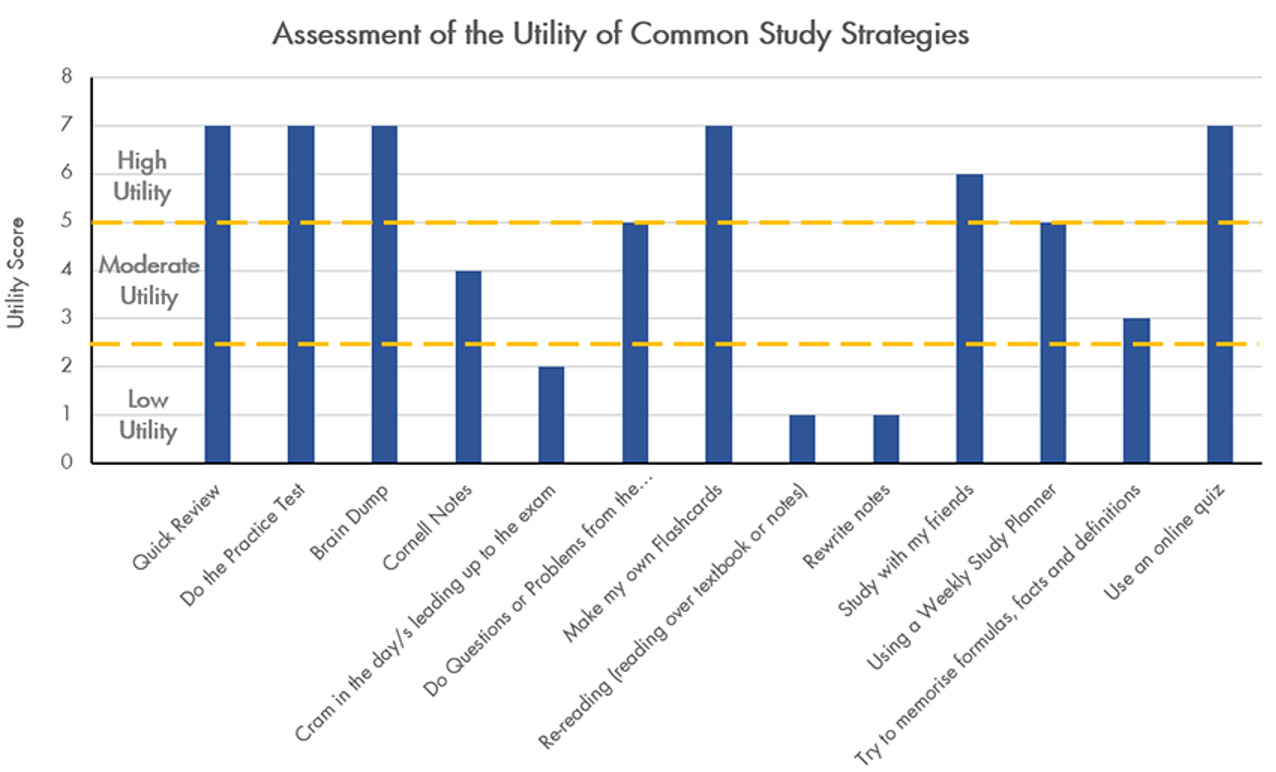How A Learner’s Toolkit transforms a student’s experience
I Know How to Study
Student belief in their ability changed when students were introduced to the A Learner’s Toolkit program. The nature of engagement (Link back to the Research Study page), had a significant impact on student belief in their ability to study.
Phase A: Represents the cohort beginning their secondary schooling journey in Year 7.
Phase B: Students were introduced to the toolkit strategies (through Years 7 to 8) through ad-hoc instruction and random experiences with different teachers in different subject
Phase C: Students engaged in explicit training in the same set of strategies in a timetabled lesson. Unlike the unstructured Phase B training approach, Phase C saw learning about specific strategies and then applying them directly in their subjects and in preparation for upcoming assessments.

Figure 1. Student self-assessment of their ability to study over time.
Not all Study Strategies are Equal
There is a common perception that all study strategies or activities are equal. However, this perception is incorrect and can lead many students to rely on study tasks that have a limited impact on learning. Some study strategies are ‘low utility’, which means you have to invest considerable time to achieve any real impact on learning gain. The most common low utility strategies that cramming, re-reading and rewriting notes.
Much of the current emphasis on the utility of strategies stems from Dunlosky et al.’s (2013) influential article ‘Improving Students’ Learning with Effective Learning Techniques: Promising Directions from Cognitive and Educational Psychology’. This research evaluates the utility of ten common study strategies using field-based collective empirical evidence (see below). In conclusion, they articulated that the higher the utility of a strategy, the greater the learning gain for the time invested.
| Technique | Description | Utility |
|---|---|---|
| Elaborative interrogation | Generating an explanation for why an explicitly stated fact or concept is true | Moderate |
| Self-explanation | Explaining how new information is related to known information or explaining steps taken during problem-solving | Moderate |
| Summarization | Writing summaries (of various lengths) of to-be-learned texts | Low |
| Highlighting / underlining | Marking potentially important portions of to-be-learned materials while reading | Low |
| Keyword mnemonic | Using keywords and mental imagery to associate verbal materials | Low |
| Imagery for text | Attempting to form mental images of text materials while reading or listening | Low |
| Rereading | Restudying text material again after an initial reading | Low |
| Practice testing | Self-testing or taking practice tests over to-be-learned material | High |
| Distributed practice | Implementing a schedule of practice that spreads out study activities over time | High |
| Interleaved practice | Implementing a schedule or practice that mixes different kinds of problems, or a schedule of study that mixes different kinds of material, within a single study session | Moderate |
Table 1. Assessment of common strategy utility (adapted from Dunlosky, J., Rawson, K. A., Marsh, E. J., Nathan, M. J., & Willingham, D. T. (2013))
The A Learner’s Toolkit evaluation tracked the longitudinal study of adolescent study tactics. The evaluation revealed some interesting trends. The student population identified 13 common study activities they frequently used. These were then analysed with a threefold focus:
- The incidence of student use of the high-utility-base cognitive strategies from A Learner’s Toolkit;
- The direct integration of the strategies into their study routine; and
- The potential opportunity for feedback (from teacher or peer). On this third measure, it should be made clear that none of the identified strategies by their design engendered feedback. Instead, feedback was only possible if the student integrated some form of formative assessment into their study routine.
A Learner’s Toolkit Study Strategy
| Study Tactics and Activities | Retrieve It | Space It | Jumble It | Connect It | Visualise It | Feedback |
|---|---|---|---|---|---|---|
| Brain dump | Yes | Yes | No | Potential | Yes | No |
| Cornell notes | No | No | No | Yes | Yes | No |
| Cram in the day/s leading up to the exam | Yes | No | No | No | No | No |
| Do questions or Problems from the textbook/OneNote | Yes | Potential | Potential | No | No | Potential |
| Do the practice test | Yes | Yes | Yes | Potential | No | Potential |
| Make/use flashcards | Yes | Yes | Yes | No | No | Potential |
| Quick review | Yes | Yes | Yes | No | No | Potential |
| Re-reading (reading over textbook or notes) | Potential | No | No | No | No | No |
| Rewrite notes | Potential | No | No | No | No | No |
| Study with my friends | Yes | Potential | Potential | Potential | No | Potential |
| Try to memorise formulas, facts and definitions | Yes | Potential | No | No | No | No |
| Using an online quiz | Yes | Yes | Yes | No | No | Potential |
| Using a weekly study planner in diary | Yes | Yes | Potential | No | No | No |
Table 2. Assessment of Common Study Tactics at Churchie that apply Underlying Cognitive Strategies of A Learner’s Toolkit
A simple algorithm was designed to measure the utility (low, moderate and high) of the common study activities used at Churchie. A numeric scale scored the incidence of the underlying A Learner’s Toolkit strategies and the 13 commonly used study tactics. The scale used was:
- 2 points: yes, the cognitive strategy is explicitly used within the study task
- 1 point: there is the potential for the cognitive strategy to be used based on student design and use of the study task
- 0 points: no, the cognitive strategy is not explicitly used within the study task
- Based on this scale, the assessment of the 13 common study strategies at Churchie revealed the following measure of utility.

Figure 2. Assessment of the Utility of Common Adolescent Study Strategies


